
Persei-Aries War Resumes
New Warships - Indian Republic
We’ve had some interest in the Indian Republic, and while reviewing their fleet and preparing them for play, I’m finding that the fleet was in need of a refresh and reorganization. So some ship classes have been renamed, designs tweaked, and new warship classes added.
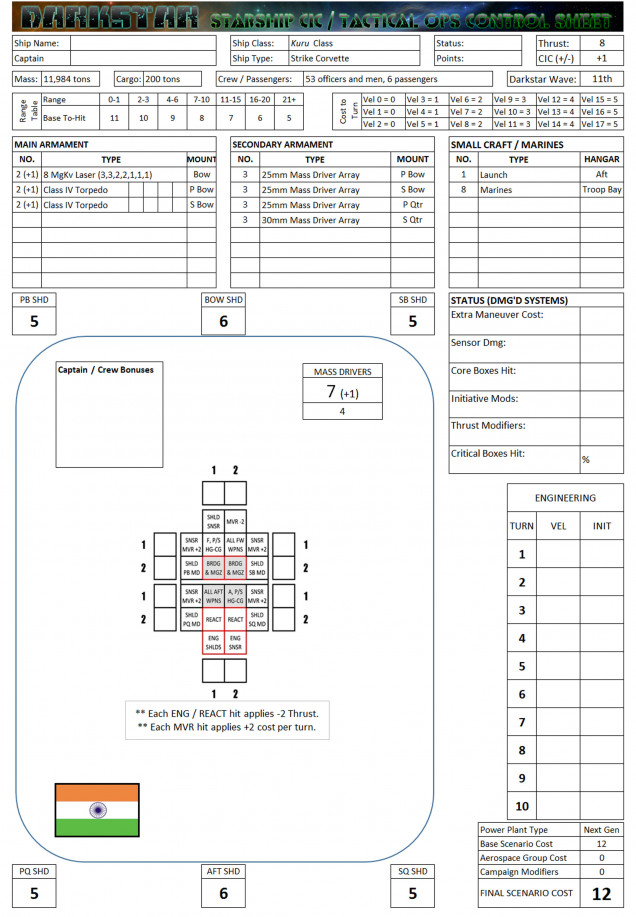 The Kuru class corvette, named for rulers of the ancient Kuru Dynasty of northen India, is the primary attack corvette deployed by the Indian Navy. Especially common in outer Second Band and Frontier star systems and warzones, the Kuru is a sleek yet austere, beautiful yet spartan design. At just under 12,000 tons, these corvettes are light for their type, fast in both sublight and FTL speeds, and able to hit hard with a suprisingly long-range weapon suite. Strictly a strike craft, the Kuru mounts everything forward, including two pair of Katara class gravitic torpedoes and a twin-mounted pair of 8 megakelvin laser emitters. Such a laser array might appear an odd choice for so small a ship (indeed, the entire front half of the ship is basically built around this turret and its powerful capacitors), but remember that such beam-based weapons are the primary and exclusive staple of Indian naval design and doctrine. Whereas most navies tend to think of corvettes as torpedo carriers (the US Mako, Russian K-56, and Prussian Type XII being prominent examples), the Kuru class is a miniature warship, able to snipe at even mid-sized enemy warships at range with their lasers their accuracy enhanced by an advanced CIC and targeting suite. One common tactic is to mass three to five of these ships together in roving packs, the combined weight of their torpedoes usually sufficient to overwhelm the shielding and point-defense of most destroyers, especially once the armor has been scored by laser fire. Several bruising wars against aerospace-heavy powers like the United States (IK Pegasi) and especially the Arab League (the Aquarius War) has also tought the Indian Navy the importance of point-defense, and four triple-mounted 25mm mass drivers ensures that no enemy torpedo volley or aerospace strike group will have a free ride on its way to a Kuru-class target. Commanders who find themselves beset by these ships should take care not to give chase, as they're fast enough to sometimes outrun enemy fighters, torpedoes, and epsecially warships. Another warning is that hit-and-fade attacks by these corvettes are often only diversions for near-suicidal "Kali Squadron" attacks by Sukanya S01 class gunboats. These ships are also sometimes used as high-level couriers or VIP transports, note the accomodations for passengers (several cabins often combined into one "luxury suite" for a Majaraja or other nobility.
The Kuru class corvette, named for rulers of the ancient Kuru Dynasty of northen India, is the primary attack corvette deployed by the Indian Navy. Especially common in outer Second Band and Frontier star systems and warzones, the Kuru is a sleek yet austere, beautiful yet spartan design. At just under 12,000 tons, these corvettes are light for their type, fast in both sublight and FTL speeds, and able to hit hard with a suprisingly long-range weapon suite. Strictly a strike craft, the Kuru mounts everything forward, including two pair of Katara class gravitic torpedoes and a twin-mounted pair of 8 megakelvin laser emitters. Such a laser array might appear an odd choice for so small a ship (indeed, the entire front half of the ship is basically built around this turret and its powerful capacitors), but remember that such beam-based weapons are the primary and exclusive staple of Indian naval design and doctrine. Whereas most navies tend to think of corvettes as torpedo carriers (the US Mako, Russian K-56, and Prussian Type XII being prominent examples), the Kuru class is a miniature warship, able to snipe at even mid-sized enemy warships at range with their lasers their accuracy enhanced by an advanced CIC and targeting suite. One common tactic is to mass three to five of these ships together in roving packs, the combined weight of their torpedoes usually sufficient to overwhelm the shielding and point-defense of most destroyers, especially once the armor has been scored by laser fire. Several bruising wars against aerospace-heavy powers like the United States (IK Pegasi) and especially the Arab League (the Aquarius War) has also tought the Indian Navy the importance of point-defense, and four triple-mounted 25mm mass drivers ensures that no enemy torpedo volley or aerospace strike group will have a free ride on its way to a Kuru-class target. Commanders who find themselves beset by these ships should take care not to give chase, as they're fast enough to sometimes outrun enemy fighters, torpedoes, and epsecially warships. Another warning is that hit-and-fade attacks by these corvettes are often only diversions for near-suicidal "Kali Squadron" attacks by Sukanya S01 class gunboats. These ships are also sometimes used as high-level couriers or VIP transports, note the accomodations for passengers (several cabins often combined into one "luxury suite" for a Majaraja or other nobility.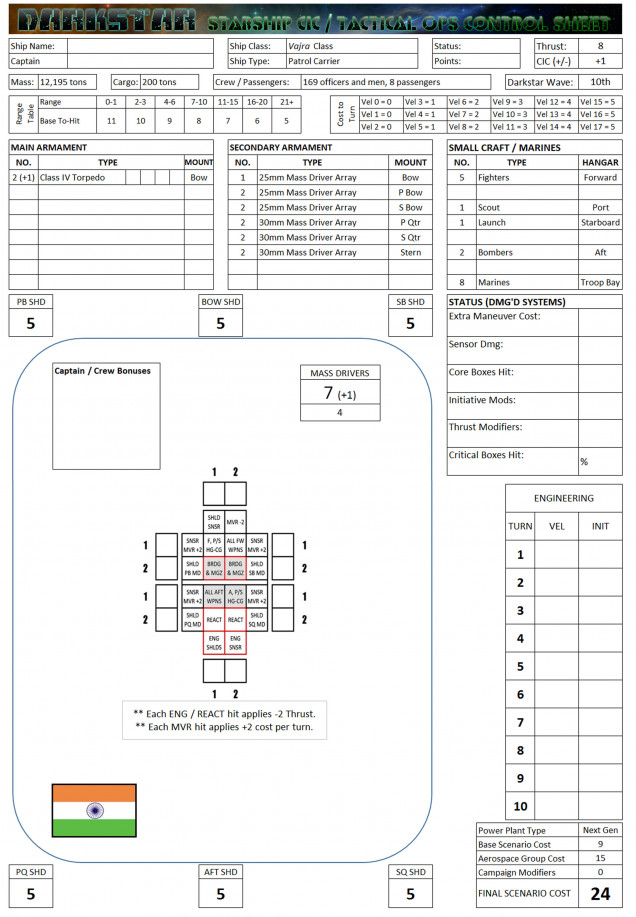 The Vajra class patrol carriers, named for the the celetstial weapons and heroes found the great war chronicles of Hindu mythology, is perhaps one of the most underestimated classes of warship, at least along the Third Band frontier. The swift little Vajras can travel between star systems on eleventh wave Darkstar drives, are respectably shielded, fiercely defend themselves with twin-mounted 20mm mass drivers on all quarters, and mount matching "Arjun" type gravitic torpedo tubes capable of pulling a hole in any ship the Vajra's size. But the Vajra's main weapon, of course, is her small but respectable air group, startlingly impressive for such a small ship. Indeed, these "corvette" class warships can launch as many fighters as most frigate-hulled escort carriers, although complements of bombers and scouts are naturally diminished. Nor can the Vajra launch or recover these aerospace craft quite as fast. Fighters usually consist of the "Chakra" class starfighter, with just one "Nakul" class bomber. Note that for some mission profiles this mix can be altered, with Vajras ditching the scout and carrying just two fighters in exchange for three bombers loaded for strike missions. But usually the fighter complement is carried, since the Vajra is used primarily for patrol, system defense, convoy escort, and screening larger task forces and fleets of the Devanagari, the Indian Navy. Whatever the mix, the Vajra class is capable of streaking into a star system, especially in hunter-killer groups of three or four, launching its aerospace group and torpedoes for a lightning strike, and zipping back out again. Conversely, the Vajra is definitely not a ship at home in toe-to-toe slugging matches, even against gun-armed corvettes or patrol boats they tend to fare poorly. In larger fleet actions they tend to either hang back with the flagships, supporting with mass driver fire or torpedoes, or sweep around an enemy wing to launch fighter strikes against targets of opportunity.
The Vajra class patrol carriers, named for the the celetstial weapons and heroes found the great war chronicles of Hindu mythology, is perhaps one of the most underestimated classes of warship, at least along the Third Band frontier. The swift little Vajras can travel between star systems on eleventh wave Darkstar drives, are respectably shielded, fiercely defend themselves with twin-mounted 20mm mass drivers on all quarters, and mount matching "Arjun" type gravitic torpedo tubes capable of pulling a hole in any ship the Vajra's size. But the Vajra's main weapon, of course, is her small but respectable air group, startlingly impressive for such a small ship. Indeed, these "corvette" class warships can launch as many fighters as most frigate-hulled escort carriers, although complements of bombers and scouts are naturally diminished. Nor can the Vajra launch or recover these aerospace craft quite as fast. Fighters usually consist of the "Chakra" class starfighter, with just one "Nakul" class bomber. Note that for some mission profiles this mix can be altered, with Vajras ditching the scout and carrying just two fighters in exchange for three bombers loaded for strike missions. But usually the fighter complement is carried, since the Vajra is used primarily for patrol, system defense, convoy escort, and screening larger task forces and fleets of the Devanagari, the Indian Navy. Whatever the mix, the Vajra class is capable of streaking into a star system, especially in hunter-killer groups of three or four, launching its aerospace group and torpedoes for a lightning strike, and zipping back out again. Conversely, the Vajra is definitely not a ship at home in toe-to-toe slugging matches, even against gun-armed corvettes or patrol boats they tend to fare poorly. In larger fleet actions they tend to either hang back with the flagships, supporting with mass driver fire or torpedoes, or sweep around an enemy wing to launch fighter strikes against targets of opportunity. 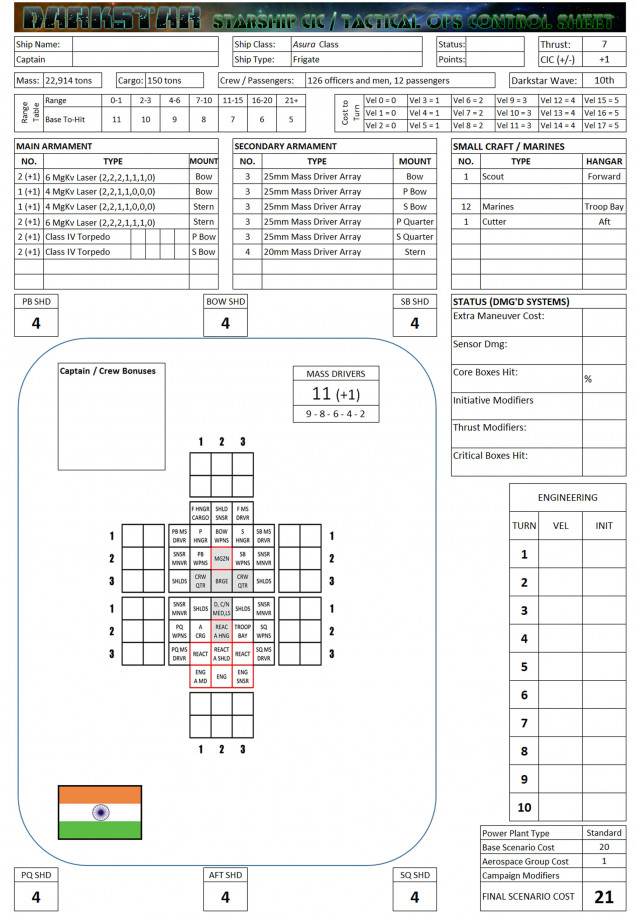 The Asura class frigate, named for a class of dangerous dieties in Hindu mythology, is fairly typical of the warships developed and deployed by the Devanagari, the Indian Navy. Armed almost exclusively with laser weapons, by far the preferred weapon of the Indian Navy, the Asura is thus light for a frigate but not especially fast, as lasers draw much more power than other classes of comparable-caliber weapons. This also means that while Asura frigates are deadly against other small ships or even destroyers, they have a very hard time contributing in a meaningful way against larger ships. For this reason, the Asura class frigates are deployed almost exclusively in the Third Band of Known Space, where cruiser-sized ships are exceedingly rare. Note the expanded cargo bays, vital for any ship that wants to operate this deep into space for extended periods of time. The Asura also has a very large passenger capacity for its class, a common feature aboard all Indian ships. This allows officers and even some senior enlisted men the option to bring members of their family with them on long deployments, and also makes Indian warships very comfortable to serve on, even if it places considerable strain on the Asura's limited available volume. Still, the Asura is a solid design, well-constructed and able to tangle with hostile ships of its own class on a very competitive basis. This is especially true if the Asura is able to keep the enemy at a distance where the range of its lasers arrays can be leveraged to maximum effect.
The Asura class frigate, named for a class of dangerous dieties in Hindu mythology, is fairly typical of the warships developed and deployed by the Devanagari, the Indian Navy. Armed almost exclusively with laser weapons, by far the preferred weapon of the Indian Navy, the Asura is thus light for a frigate but not especially fast, as lasers draw much more power than other classes of comparable-caliber weapons. This also means that while Asura frigates are deadly against other small ships or even destroyers, they have a very hard time contributing in a meaningful way against larger ships. For this reason, the Asura class frigates are deployed almost exclusively in the Third Band of Known Space, where cruiser-sized ships are exceedingly rare. Note the expanded cargo bays, vital for any ship that wants to operate this deep into space for extended periods of time. The Asura also has a very large passenger capacity for its class, a common feature aboard all Indian ships. This allows officers and even some senior enlisted men the option to bring members of their family with them on long deployments, and also makes Indian warships very comfortable to serve on, even if it places considerable strain on the Asura's limited available volume. Still, the Asura is a solid design, well-constructed and able to tangle with hostile ships of its own class on a very competitive basis. This is especially true if the Asura is able to keep the enemy at a distance where the range of its lasers arrays can be leveraged to maximum effect. 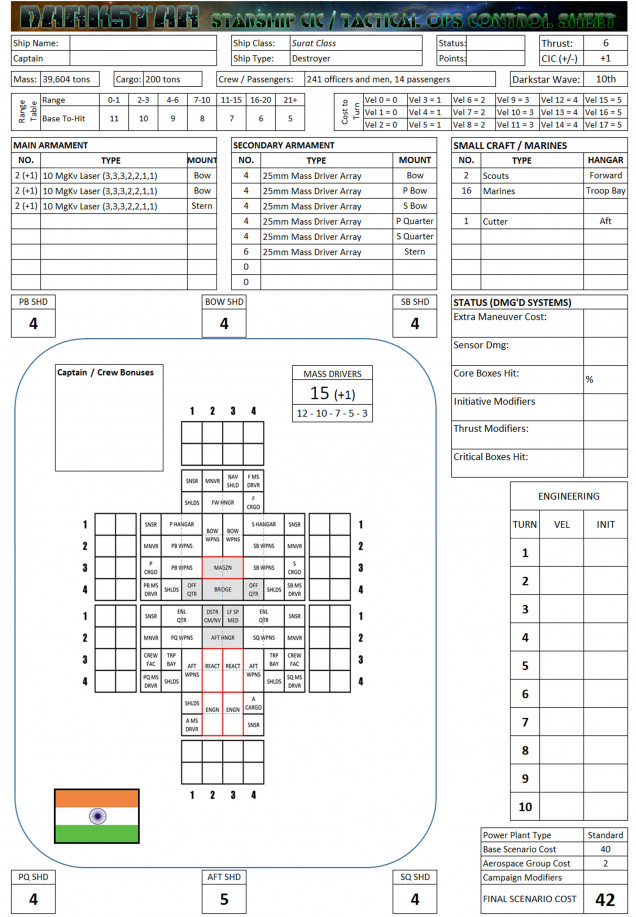 The Surat class destroyer is an older design of the Devanagari, or Indian Navy, but one that the fleet seems unwilling to part with. Production run on these destroyers began over thirty years ago, but their rugged service in fleet support, sector patrol, and open combat has proven solid enough that some shipyards are rumored to still be building upgraded and modernized variants of the class. A big reason for their effectiveness and popularity could be the weapons suite, with no less than six 10 MgKv lasers these destroyers are extremely effective and supporting bigger ships in bigger battles, where fleet commanders prefer to keep longer engagement ranges. With an upgraded sensor, targeting, and command suite, the Surats have kept reasonable pace with the state of electronics warfare, lending further accuracy and effective range to these lasers. The shielding, sublight speed, amass driver defenses, and Darkstar capability -- while unremarkable -- are still solid for the Surat's class. One possible weakness could be the relative lack of secondary armaments, with just four torpedo tubes (torpedoes are usually a destroyer's bread and butter) the Surat becomes something of a "one trick pony" with its powerful lasers. Fortunately for the Surat, that pony has a potent kick. In the seemingly endless (and near-genocidal) 2486-2502 Aquarius War against the Arab League, Surat destroyers suffered somewhat against larger classes of warships, whose larger components are not as easily effected by the pinpoint drilling effect of lasers. Against smaller ships, however, the ships became veritable angels of death. They also picked up the reputations as "executioners," finishing off targets already damaged by bigger ships' rail guns, plasma arrays, and torpedoes. Always in the thick of the action in this war, Surats took heavy losses, but also racked up impressive victory tallies, and the Indian Navy seems intent on continuing production on this venerable class, albeit on a limited basis. They are named after mid-sized cities of the terrestrial Indian Republic.
The Surat class destroyer is an older design of the Devanagari, or Indian Navy, but one that the fleet seems unwilling to part with. Production run on these destroyers began over thirty years ago, but their rugged service in fleet support, sector patrol, and open combat has proven solid enough that some shipyards are rumored to still be building upgraded and modernized variants of the class. A big reason for their effectiveness and popularity could be the weapons suite, with no less than six 10 MgKv lasers these destroyers are extremely effective and supporting bigger ships in bigger battles, where fleet commanders prefer to keep longer engagement ranges. With an upgraded sensor, targeting, and command suite, the Surats have kept reasonable pace with the state of electronics warfare, lending further accuracy and effective range to these lasers. The shielding, sublight speed, amass driver defenses, and Darkstar capability -- while unremarkable -- are still solid for the Surat's class. One possible weakness could be the relative lack of secondary armaments, with just four torpedo tubes (torpedoes are usually a destroyer's bread and butter) the Surat becomes something of a "one trick pony" with its powerful lasers. Fortunately for the Surat, that pony has a potent kick. In the seemingly endless (and near-genocidal) 2486-2502 Aquarius War against the Arab League, Surat destroyers suffered somewhat against larger classes of warships, whose larger components are not as easily effected by the pinpoint drilling effect of lasers. Against smaller ships, however, the ships became veritable angels of death. They also picked up the reputations as "executioners," finishing off targets already damaged by bigger ships' rail guns, plasma arrays, and torpedoes. Always in the thick of the action in this war, Surats took heavy losses, but also racked up impressive victory tallies, and the Indian Navy seems intent on continuing production on this venerable class, albeit on a limited basis. They are named after mid-sized cities of the terrestrial Indian Republic.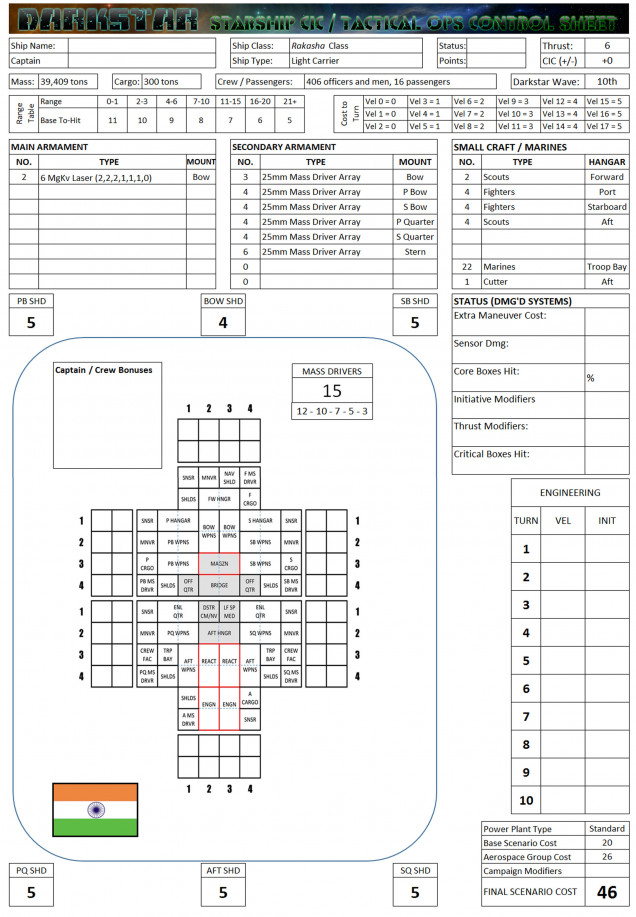 The Rakasha light carrier, named for legendary demons and demonesses in Hindu mythology, has been a fairly successful starship class built to project Indian aerospace power deeper into known space. Conceived originally as something of a stopgap while larger classes of fleet carriers were built, the Rakasha carriers in fact proved to be tough, reliable, and flexible aerospace strike platforms. They are admittedly an older design, dating back from the closing days of the long and brutal Aquarius War against the Arab League. They underwent something of an overhaul and modernization whgen the new Chakra class aerospace fighter was introduced, requiring significant redesign of the Rakashas' launch bays and hangar facilities. While a long and expensive process, the the effort proved worthwhile given the quantum improvement of the Chakra over the older Dhanush (Longbow) class fighter. Analysts agree that this enhanced aerospace superiority and strike capacity has added at least twenty years to the service life of the Rakasha class light carrier. The Rakasha is somewhat unusual for a ship of this type, dispensing with the usual torpedo arrays and instead mounting the staple of the Indian Navy, the long-ranged laser. With just two emitters mounted in a forward turret, these weapons are strictly secondary, and of course cannot directly support the Rakasha's aerospace strike with further ship-launched warheads. However, experience has shown that while the Rakasha is launching, assembling, and deploying its aerospace strike (usually at least three minutes after the onset of an engagement), even a few drilling laser hits by these weapons can sometimes be enough to make a critical difference in the final effectiveness of such an aerospace strike, especially in aerospace torpedoes or missiles hit in areas previously damaged. In all, the Rakasha is a solid if unremarkable design, reliable if not fantastic, well-trusted by crews and commanders, and sure to see service in the Indian Navy for at least the foreseeable future.
The Rakasha light carrier, named for legendary demons and demonesses in Hindu mythology, has been a fairly successful starship class built to project Indian aerospace power deeper into known space. Conceived originally as something of a stopgap while larger classes of fleet carriers were built, the Rakasha carriers in fact proved to be tough, reliable, and flexible aerospace strike platforms. They are admittedly an older design, dating back from the closing days of the long and brutal Aquarius War against the Arab League. They underwent something of an overhaul and modernization whgen the new Chakra class aerospace fighter was introduced, requiring significant redesign of the Rakashas' launch bays and hangar facilities. While a long and expensive process, the the effort proved worthwhile given the quantum improvement of the Chakra over the older Dhanush (Longbow) class fighter. Analysts agree that this enhanced aerospace superiority and strike capacity has added at least twenty years to the service life of the Rakasha class light carrier. The Rakasha is somewhat unusual for a ship of this type, dispensing with the usual torpedo arrays and instead mounting the staple of the Indian Navy, the long-ranged laser. With just two emitters mounted in a forward turret, these weapons are strictly secondary, and of course cannot directly support the Rakasha's aerospace strike with further ship-launched warheads. However, experience has shown that while the Rakasha is launching, assembling, and deploying its aerospace strike (usually at least three minutes after the onset of an engagement), even a few drilling laser hits by these weapons can sometimes be enough to make a critical difference in the final effectiveness of such an aerospace strike, especially in aerospace torpedoes or missiles hit in areas previously damaged. In all, the Rakasha is a solid if unremarkable design, reliable if not fantastic, well-trusted by crews and commanders, and sure to see service in the Indian Navy for at least the foreseeable future.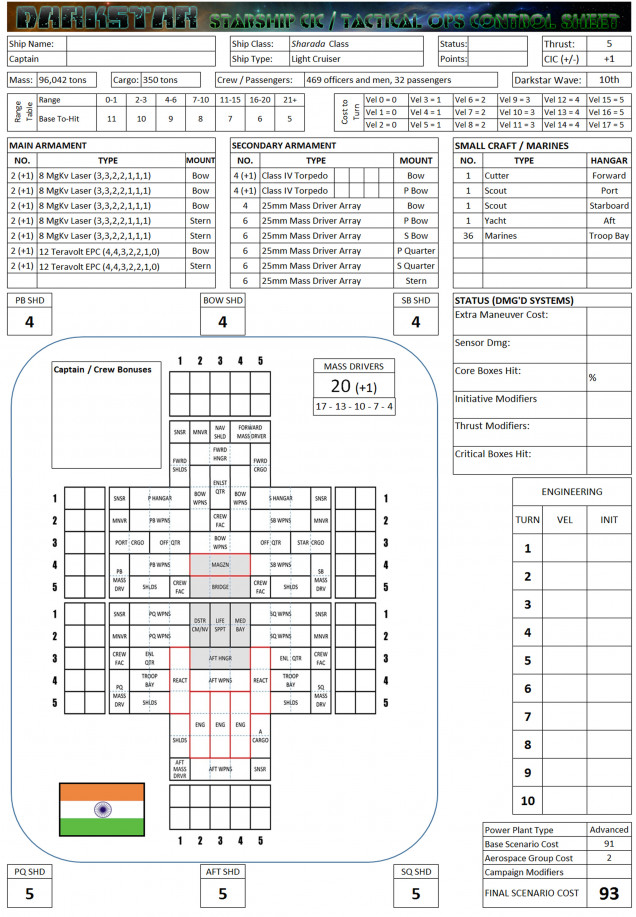 The Sharada class light cruiser is one of the newer warships coming off the slips of the Indian Republic, named for famous admirals in the early days of their interplanetary (and later interstellar) navy. Like most Indian warships, the Sharadas are sleek, beautiful, and very advanced, although not exactly heavy hitters in a capital ship action. With an advanced DT-fusion reactor assembly turning the gears down in engineering, the Sharada is anything put underpowered. The Sharadas are mounted with an advanced "Aakash 870" model targeting, command, control, and comms array, along with respectable Darkstar and ion drives for sublight propulsion. Yet for all these attributes, the Sharadas were not perfect. Originally, the ship was faster, but mounted only their four turrets of double-mounted 8 MgKv laser emitters. But early experience in combat against the Arab Leage, Chinese, and rogue British "privateers" showed that while these weapons can certainly shoot holes in hulls, the odds of significant internal damage (decompression, internal explosions, engine shut-downs) was pretty slim. For this reason, the Sharada class was pulled in and retrofitted with the new 12-teravolt EPCs. This slowed the ship down, and cut into the family quarters (always extensive on Indian warships, see the expanded passenger accomodations). But even the most diehard Indian naval design officer had to admit that no cruiser can outrun rail guns, and bringing your family along in space doesn't do much good if you can't protect them. After the refit, two Sharada class cruisers (Anasuya and Zinta) were escorting an Indian settlement convoy when they were attacked by a Russian "wolfpack" of Russian destroyers and K-56 class corvettes. Complemented by their new EPCs and torpedo arrays, the two cruisers quickly exploded three of the corvettes and crippled a destroyer, putting the rest of the Russian raiders to hasty flight. Another ship of the class, the Kharnanda, sailed under the flag of the the Maharani Jaya Amritachandra (Victory of the Eternal Moon) during the recent IK Pegasi conflict. As the flagship of the Indian battlegroup, she nearly turned the tide of victory against the Arab League and Americans at the climactic battle of Jebel al Itaqu.
The Sharada class light cruiser is one of the newer warships coming off the slips of the Indian Republic, named for famous admirals in the early days of their interplanetary (and later interstellar) navy. Like most Indian warships, the Sharadas are sleek, beautiful, and very advanced, although not exactly heavy hitters in a capital ship action. With an advanced DT-fusion reactor assembly turning the gears down in engineering, the Sharada is anything put underpowered. The Sharadas are mounted with an advanced "Aakash 870" model targeting, command, control, and comms array, along with respectable Darkstar and ion drives for sublight propulsion. Yet for all these attributes, the Sharadas were not perfect. Originally, the ship was faster, but mounted only their four turrets of double-mounted 8 MgKv laser emitters. But early experience in combat against the Arab Leage, Chinese, and rogue British "privateers" showed that while these weapons can certainly shoot holes in hulls, the odds of significant internal damage (decompression, internal explosions, engine shut-downs) was pretty slim. For this reason, the Sharada class was pulled in and retrofitted with the new 12-teravolt EPCs. This slowed the ship down, and cut into the family quarters (always extensive on Indian warships, see the expanded passenger accomodations). But even the most diehard Indian naval design officer had to admit that no cruiser can outrun rail guns, and bringing your family along in space doesn't do much good if you can't protect them. After the refit, two Sharada class cruisers (Anasuya and Zinta) were escorting an Indian settlement convoy when they were attacked by a Russian "wolfpack" of Russian destroyers and K-56 class corvettes. Complemented by their new EPCs and torpedo arrays, the two cruisers quickly exploded three of the corvettes and crippled a destroyer, putting the rest of the Russian raiders to hasty flight. Another ship of the class, the Kharnanda, sailed under the flag of the the Maharani Jaya Amritachandra (Victory of the Eternal Moon) during the recent IK Pegasi conflict. As the flagship of the Indian battlegroup, she nearly turned the tide of victory against the Arab League and Americans at the climactic battle of Jebel al Itaqu. Until relatively recently, the Magadha class light cruiser was seen as a glaring weakness in the Indian Navy, and perhaps any long-range prospects of the Indian Republic as amn interstellar colonial power at all. Named for the ancient monarchs of the Magadha dynasties, the Magadha cruisers actually began their careers with promise, their dizzying array of 6-megakelvin lasers burning holes through virtually every opponent they came across. The advent of the Aquarius War, however, put the Magadhas up against new threats the design was not prepared for, heavy concentrations of Arab League aerospace groups and Russian torpedo spreads. Heavy damage to several vessels, including a few explosions, scuttlings, or total write-offs, prompted immediate upgrades to the ship's mass driver defenses, but this only slowed the ships down, making them easy meat for Arab Shabbak-class gunboats and Russian torpedo corvettes. A second round of refits with lighter, more power-efficient 25mm mass drivers largely corrected the issue, but by then the embattled Magadhas were twenty-five years old. Formerly a "dreadnought" in duels against enemy light cruiser, destroyers, and frigates, these ships found themselves up against more heavy cruisers or advanced light cruisers. Those 6-megakelvin lasers, plentiful as they were, just weren't heavy enough to cripple enemies of this caliber, especially since the Magadha had to get so close for them to appreciable damage. Finally, the Sharada class light cruiser was introduced. While a "replacement" ship class usually sounds the death knell of the older type, for the Magadha the new stablemate provided a second lease on life. Relieved of task force and battlegroup flag ship duties, the Magadha found a new role as capital ship escorts for the larger Gujarat class heavy cruisers, Naga class strike carriers, Maya class fleet carriers, and Kali class battleships. The Magadhas' relatively modest speed is no issue here, their huge volume of smaller-caliber weapons makes them ideal for fending off smaller ships that love to prey on larger ship's sterns and engineering sections, and their upgraded point-defense systems allow for solid support against enemy aerospace attacks. Losses, damage, and drydock time have fallen off sharply, and the venerable old Magadha class have settled in their new role, often seen as "prestige" ships in a task force given their long and storied careers.
Until relatively recently, the Magadha class light cruiser was seen as a glaring weakness in the Indian Navy, and perhaps any long-range prospects of the Indian Republic as amn interstellar colonial power at all. Named for the ancient monarchs of the Magadha dynasties, the Magadha cruisers actually began their careers with promise, their dizzying array of 6-megakelvin lasers burning holes through virtually every opponent they came across. The advent of the Aquarius War, however, put the Magadhas up against new threats the design was not prepared for, heavy concentrations of Arab League aerospace groups and Russian torpedo spreads. Heavy damage to several vessels, including a few explosions, scuttlings, or total write-offs, prompted immediate upgrades to the ship's mass driver defenses, but this only slowed the ships down, making them easy meat for Arab Shabbak-class gunboats and Russian torpedo corvettes. A second round of refits with lighter, more power-efficient 25mm mass drivers largely corrected the issue, but by then the embattled Magadhas were twenty-five years old. Formerly a "dreadnought" in duels against enemy light cruiser, destroyers, and frigates, these ships found themselves up against more heavy cruisers or advanced light cruisers. Those 6-megakelvin lasers, plentiful as they were, just weren't heavy enough to cripple enemies of this caliber, especially since the Magadha had to get so close for them to appreciable damage. Finally, the Sharada class light cruiser was introduced. While a "replacement" ship class usually sounds the death knell of the older type, for the Magadha the new stablemate provided a second lease on life. Relieved of task force and battlegroup flag ship duties, the Magadha found a new role as capital ship escorts for the larger Gujarat class heavy cruisers, Naga class strike carriers, Maya class fleet carriers, and Kali class battleships. The Magadhas' relatively modest speed is no issue here, their huge volume of smaller-caliber weapons makes them ideal for fending off smaller ships that love to prey on larger ship's sterns and engineering sections, and their upgraded point-defense systems allow for solid support against enemy aerospace attacks. Losses, damage, and drydock time have fallen off sharply, and the venerable old Magadha class have settled in their new role, often seen as "prestige" ships in a task force given their long and storied careers.































![How To Paint Moonstone’s Nanny | Goblin King Games [7 Days Early Access]](https://images.beastsofwar.com/2024/12/3CU-Gobin-King-Games-Moonstone-Shades-Nanny-coverimage-225-127.jpg)







































Nice these all look really cool.
By the looks of the Sharada it appears they do not have any Lube on the Subcontinent? Damn that thing packs some nice firepower.
Looking forward to facing these tomorrow
Thanks, @elessar2590 . Every navy in the Darkstar has a certain “flavor” and the Indians love lasers (to include syglex emitters as well, basically an X-ray “laser”). The “neatness” and elegance of the weapon appeals to their navy’s aesthetic, as opposed to more “rude” and “messy” weapons like rail guns and plasma accelerators. 😀 In tonight / tommorow’s game against @muakhah you’ll actually be up against a star caliphate of the Arab League. At least in the immediate sense, the Indians are being built / reorganized for @damon and @gladesrunner – who might be using them as “secondary factions” in… Read more »
Glad the Indians have been brought out of moth balls! I need to get my bloody girls back into action!